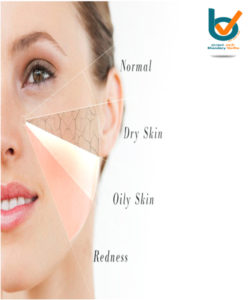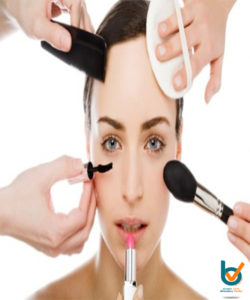
 Determine your skin type and buy skin-care products to suit it. This is extremely important.Products that are not appropriate for your skin type will not only be ineffective, they may exacerbate and worsen the condition of your skin. In buying products you should also take into consideration other specific concerns, such as acne, rosacea, and inflammation.
Determine your skin type and buy skin-care products to suit it. This is extremely important.Products that are not appropriate for your skin type will not only be ineffective, they may exacerbate and worsen the condition of your skin. In buying products you should also take into consideration other specific concerns, such as acne, rosacea, and inflammation.
- Normal Skin
Normal skin is smooth and firm to the touch, with small or medium-sized pores. It is neither too dry nor too oily, and has only an occasional blemish. A normal-skin-care regimen should consist of cleanser, moisturizer, and occasional spot treatment.
- Dry Skin
Dry skin often feels very tight and is noticeably flaky/scaly and red—at least in some areas; it can look red and bumpy. Dry skin is commonly caused by lack of hydration; therefore, a dry-skin regimen requires a gentle cleanser, day moisturizer, and a deeply moisturizing night cream.
- Oily Skin
Oily skin is visibly shiny and feels slightly wet to the touch. It is often associated with large pores that are more noticeable, and it is usually more prone to blemishes. Oily skin requires a regimen of cleansing, toning, periodic exfoliation, spot treatment, and only light moisturization—preferably with serums and lotions.
- Combination Skin
Combination skin is a blend of various skin types. If you have combination skin, you tend to get oily around your nose, chin, and forehead area and dry around your cheeks. The rest of your skin is relatively normal. If you have combination skin, your daily regime should consist of exfoliation, cleansing, moisturizing, and a spot treatment.
- Sensitive Skin
Sensitive skin is characterized as easily irritable and inflamed. It may have strong, burn-like reactions to certain cosmetics, dramatic changes in weather, and other environmental and nutritional exposures. If you have sensitive skin, use a series of cleanser, moisturizer, and spot treatment whose components are all suitable for sensitive skin only.
Tip: A word about allergies. If you have sensitive skin or if you are concerned about the possibility of skin irritation or the development of allergic reactions, consider performing an informal “patch allergy test.” Simply apply the compound to be tested (moisturizer, makeup, cleanser) on the inner aspect of your forearm and cover it with the bandage. Continue daily application of the cosmetic in exactly the same location for about 3 to 5 days and look for any signs of skin inflammation—i.e., redness, itchiness, dryness. If after several days of application your skin looks absolutely normal, it is safe to use the cosmetic on your face.
Be kind and gentle to your skin. Do not aggressively rub, pull, or stretch your skin. Be especially careful with the thin skin of the eyelids. With repeated stretching, skin may lose its elastic recoil ability and become loose and saggy.
Never pick at your skin; never squeeze or pop acne blemishes. Picking at your skin may result in temporary skin discoloration and even permanent scarring. Discoloration occurring after any skin trauma varies, depending on the skin type. People with light skin tend to develop red scars, which become less red and more-skin colored with time. People with darker skin tones tend to develop hyper-pigmented or dark scars that fade slowly over months to years. In the worst-case scenario, picking at skin may result in damage to the collagen matrix and may result in permanent depressed scar.
Don’t touch your face. This is especially important for those with oily and acne-prone skin. You can transfer oil residue and countless bacteria from your hands, cell phones, hats, helmets to your face by simply touching it. Dirt mixed with cellular debris may become trapped in your pores, causing their dilation and even the development of inflammatory, acne-like lesions. Also consider other oils and pore-clogging substances—like oil from unwashed hair, makeup application brushes, shampoo and conditioner residue, and residual makeup.
Tip: Wash your face after shampooing and conditioning to remove any residue from the surface of your skin. And, of course, the No. 1 requirement: Always wash your hands thoroughly with soap and warm water before touching your face. You might also consider make-up remover cleansing towelettes. Oil-absorbent paper also works well, but use it only once, otherwise you risk the transfer of oil and dirt back to your face.

CLEANSER, TONER, MOISTURIZER
Cleansing
Opt for gentle or sensitive cleansing products (CeraVe Hydrating Cleanser, Cetaphil, Neutrogena Makeup Remover Cleansing Towelettes, Neocutis Neo-Clense Gentle Skin) that will remove excess oil and promote healthy, clear skin without the use of harsh chemicals. If your skin feels tight, dry, or sore after cleansing, I suggest that your facial wash is too harsh for your skin.
Oily and acne-prone skin may benefit from cleansers with salicylic acid that is lipophilic (dissolves oil) and penetrates deep inside the pores (Neutrogena Oil-Free Acne Wash). Unless you have active acne lesions on your face the majority of the time, you should not use harsh benzoyl peroxide–containing products (Clean & Clear, Noxema, Oxy, or Clearasil). These products are way too harsh and strip the skin’s natural oils, leaving skin very dry and uncomfortable.
Sensitive skin requires the use of a gentle cleanser. Opt for cleansers designed to repair skin’s natural barrier with ceramides as active ingredients (Cerave Hydrating Cleanser, Cetaphil, Dove, SkinCeuticals Gentle Cleanser).
Aging skin, often characterized by the accumulation of turned-over keratinocytes and lack of radiance, may require chemically exfoliating cleansers with alpha hydroxyacids such as glycolic acid (SkinCeuticals LHA Cleansing Gel). .
Face-washing “etiquette”
- Wash your hands to avoid transfer of bacteria to your face.
- Wet your skin with warm water to gently dilate the pores. Apply the cleanser and massage it into your skin in gentle upward, circular motions. Some products, especially products with salicylic and glycolic acid, will work best if you leave them on for a minute or so to allow them to dissolve trapped oil, dirt and makeup.
- Remove the cleanser with damp cotton pads, washcloth, or by splashing with warm water. Never leave any cleanser on your face, as this encourages irritation.
- Finish cleansing by rinsing your skin with cold water to close up the pores. Cool water will also leave you looking more fresh-faced, and less red.
- Dry your face gently by dabbing, not rubbing, it with a clean towel or paper towels.
Tip: Never go to bed without completely removing your makeup. This will give your skin a chance to heal and restore overnight. Consider a pack of Neutrogena Makeup Remover Cleansing Towelettes on your night stand for those late nights on the town.
Toning
A few minutes after cleansing, tone your face. Toner helps to restore your skin’s natural pH levels, altered during cleansing. By restoring your skin to its natural pH, you will limit skin’s inflammation and make it more resistant to bacteria and micro-organisms.
Tip: Do not rinse off the toner!
Moisturizing
Moisturize within minutes of the washing/toning of your face.
Moisturizing is a crucial part of the skin-care protocol, especially for mature skin (skin in a person over the age of 35). In choosing the right moisturizer, two things matter: base of the product (cream, gel, ointment) and the active ingredient of the formulation.
In general, ointments are more moisturizing than creams, and creams are more moisturizing than lotions. Gels are least moisturizing, and therefore best for oily/acne-prone skin. Creams and ointments are best for dry/sensitive skin, and light serums work best for normal/oily skin.
Look for a “multifunctional” moisturizer that targets multiple skin concerns in addition to simply moisturizing. New generations of moisturizers offer value added benefits.
For daytime:
Look for moisturizers with antioxidants to combat oxidative damage from UV exposure, environmental exposures, poor diet and chronological aging. Look for preparations with vitamin C (ascorbic acid), vitamin E, ferrulic acid (SkinCeuticals C E Ferulic, Phloretin CF, Obagi Professional C-Serum, NeocutisReACTIVE), resveratrol (SeSdermaResveradermAntiOX), green tea extract.
Tip: A quick note on vitamin C. In addition to being a potent antioxidant, vitamin C stimulates collagen synthesis, inhibits synthesis of melanin (skin pigment prominent in sunspots), brightens complexion, and is, therefore, a cornerstone of the skin-care regimen. However, vitamin C is inherently extremely unstable, especially in formulations containing water (such as creams and serums) and upon exposure to high temperatures and light.
For optimal benefits, consider vitamin C formulations in water–free serums and gels, and store them in dark containers in the fridge.
For nighttime:
For nighttime choose moisturizers with growth factors and collagen stimulators to restore and rebuild collagen and elastic fibers (Neocutis Bio Serum, Olay Regenerist line) and products containing retinoids.
Topical retinoids, over-the-counter retinol, and the prescription-strength retinoic acid (biological strength of the retinoic acid is over 100 times of that of retinol), are cornerstones of the anti-acne and anti-aging therapy (RoC Retinol Correxion Night Cream, Neocutis Nouvelle Plus Retinol Correction Cream). They have been shown in numerous clinical studies to stimulate new collagen and elastic-fibers synthesis and diminish the appearance of sunspots and discolorations, resulting in improved skin firmness, reduced appearance of fine lines and wrinkles and contributing to more uniform skin tone.
Invest in proper skin care and you will invest in the future health of your skin.







